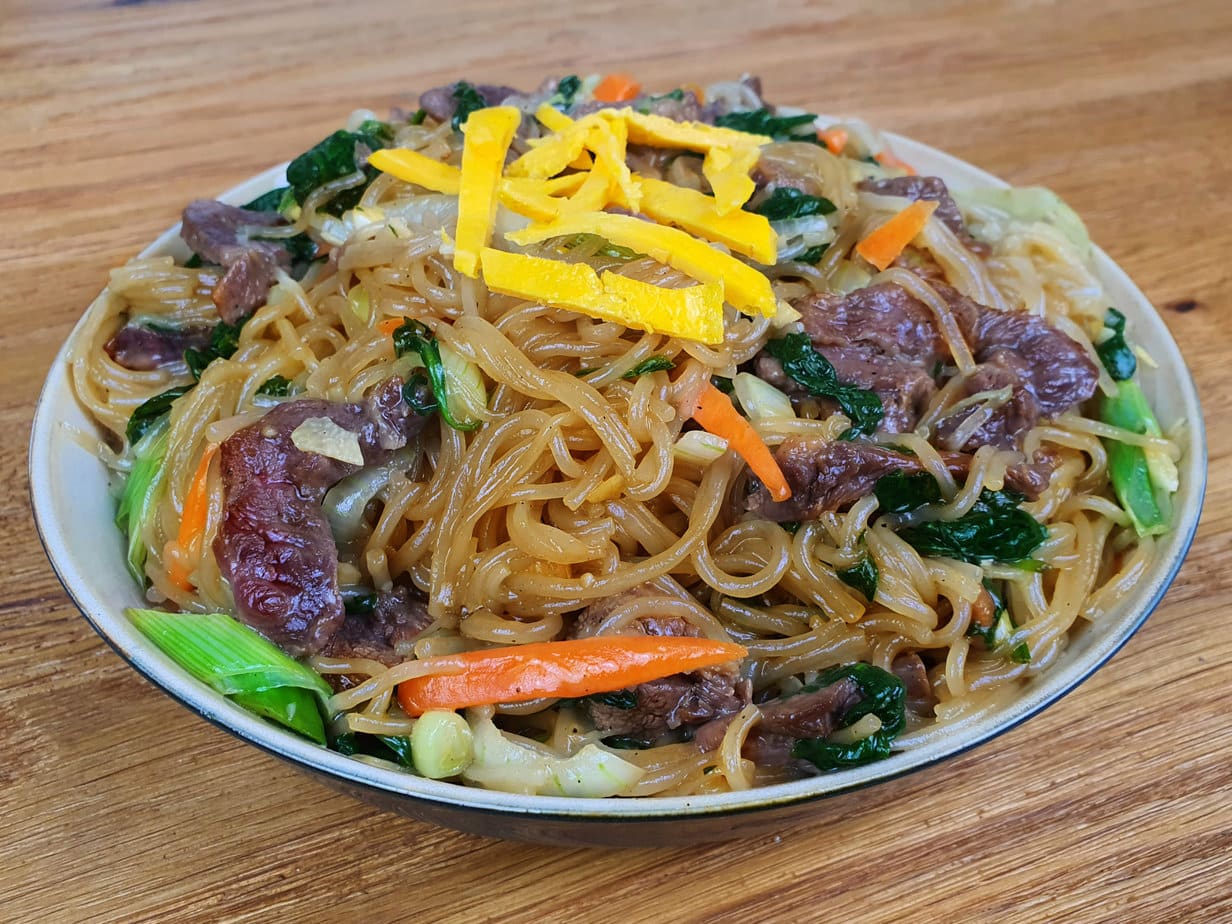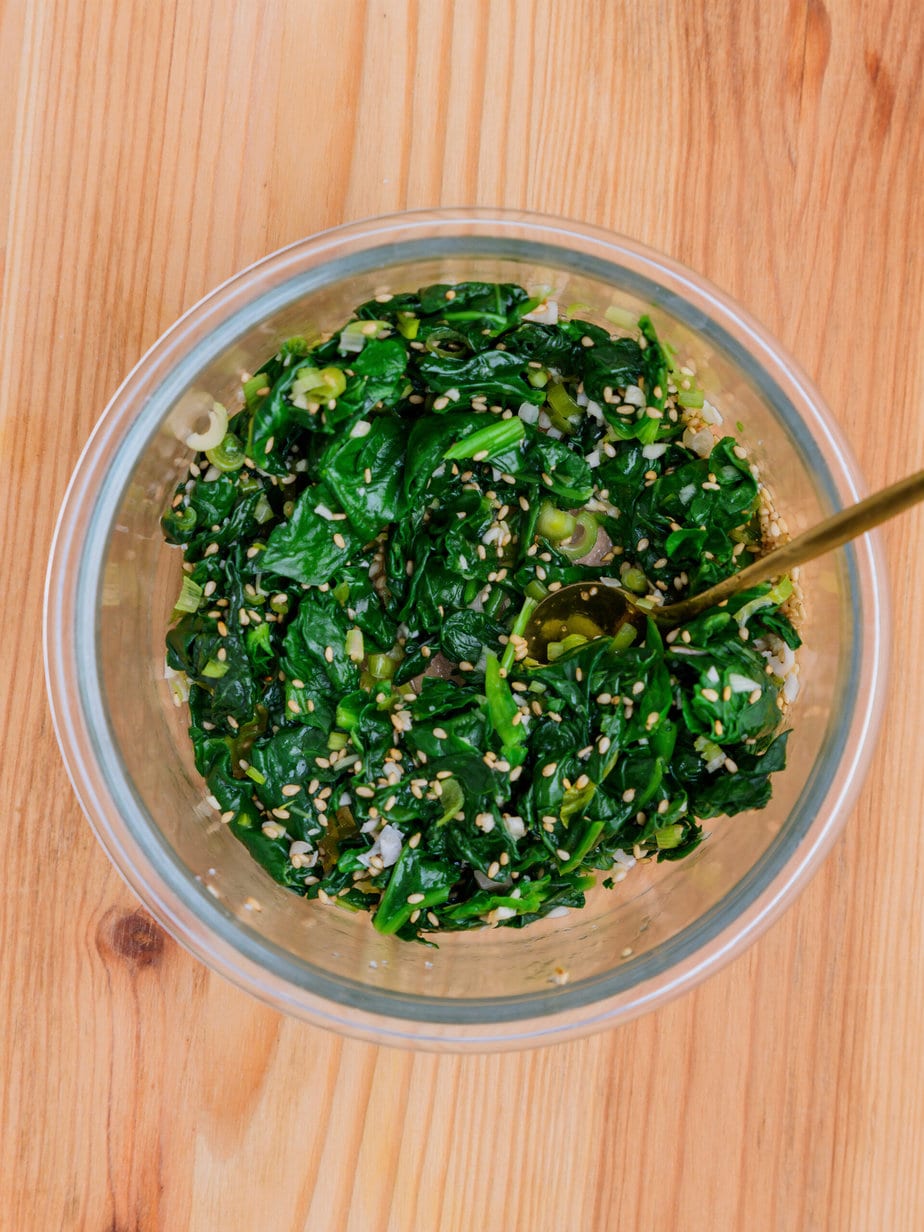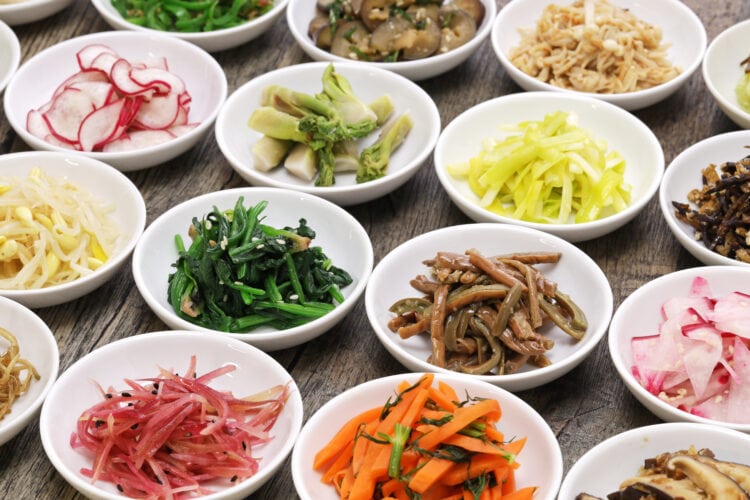Banchan are much more than simple side dishes; they are a symbol of Korean hospitality and generosity. Served in small portions, these Korean dishes are designed to be shared, thus encouraging conviviality and sharing at the table.
Among the most iconic Banchan, we find Kimchi (김치), spicy and crunchy fermented vegetables, often made with napa cabbage or radish. Japchae (잡채), a dish of sweet potato noodles stir-fried with vegetables and sometimes meat, is also a favorite.

Pajeon (파전), a type of green onion pancake, offers a crispy texture and savory taste that perfectly complements main dishes.
The Different Types of Banchan
Under the umbrella term of Banchan, we find several subcategories:
Kimchis 김치: Essential to the Korean table, these fermented vegetables marinated in a spicy sauce are a pillar of gastronomy. Chinese cabbage is often used, but chives, leeks, and cucumbers are also popular. Fermentation ensures long-term preservation, making Kimchis a culinary heritage passed down for centuries.
Namul 나물: Prepared from sautéed, boiled, or steamed vegetables, these banchan are then seasoned with sesame oil. Fresh and light, they should be consumed quickly after preparation to savor their freshness. I discuss them in more depth later in this article.
Jorim 조림: These dishes simmered in a rich sauce, often soy sauce-based, are a delight for the taste buds. The soy sauce used in the marinades not only enhances the flavor but also extends the shelf life of these banchan.
Jjim 찜: This group includes steamed dishes, such as fluffy omelets (Gyeranjjim) or fish. They should be consumed immediately and do not keep well.
Bokkeum 볶음: These dishes, where meats and vegetables are sautéed in a spicy sauce or soy sauce, often serve as main dishes. They can be kept for a few days, offering a delicious and practical option.
Jeons 전: These pan-fried pancakes, made with various vegetables or meats, are a specialty enjoyed during family gatherings and holidays such as Chuseok, demonstrating their prominent place in Korean culinary culture.
Focus on Namul
Among the Banchan, Namul (나물) hold a special place. These dishes consist of vegetables or wild herbs, blanched and seasoned with sesame oil, garlic, chili, and other spices.
Namul can be served fresh or lightly sautéed, preserving the crunchy texture of the vegetables while enriching them with a deep and aromatic flavor. The varieties of Namul are endless, with each season offering its own vegetables and herbs to transform into delicious side dishes.
Notable examples include Sigeumchi-namul (시금치나물), seasoned spinach, and Kongnamul (콩나물), crunchy bean sprouts. These dishes are often enhanced with garlic, roasted sesame seeds, and soy sauce, creating a perfect balance between earthy flavors and umami notes.

Gaji-namul (가지나물), made with eggplant, and Doraji-namul (도라지나물), prepared with Korean bellflower roots, are also common Namul in Korea, though absent from restaurant menus in Europe.
A Balance Between Tradition and Innovation
The preparation of Banchan and Namul is a living testament to Korean culinary traditions, passed down from generation to generation. However, this does not prevent innovation.
Contemporary chefs and home cooking enthusiasts experiment with non-traditional ingredients and modern techniques to create new and surprising versions of these classic dishes. This fusion between the old and the new highlights the flexibility of Korean cuisine and its continuous adaptation to an ever-changing world.
Nutrition and Well-being
Beyond their cultural and gustatory role, Banchan and Namul play a crucial role in the balanced Korean diet. Rich in fiber, low in calories, and packed with vitamins and minerals, these dishes promote a healthy and varied diet. They are a cornerstone of the Korean diet, which is often cited as one of the most balanced and beneficial for health.
Banchan and Namul are not just simple dishes; they are an invitation to discover the richness of Korean culture through its cuisine. Each small dish is a doorway to the history, traditions, and values of a people who celebrate life through their food. The next time you have the opportunity to taste these delicacies, remember that each bite carries within it the spirit of sharing, health, and harmony that defines Korean cuisine.
Preserving Banchan
Faced with famines, food shortages, and harsh winters, Koreans have refined their preservation techniques, giving rise to a variety of Banchans that can be stored from a few days to several months in the refrigerator. This ability to extend the shelf life of foods demonstrates not only culinary expertise but also ingenuity born of necessity.
Today, Korean households often have a range of Banchans ready to complement their meals, a practice facilitated by the existence of specialized stores. Although buying Banchans is convenient, preparing them at home during the weekend, using fresh ingredients from the market, offers a special satisfaction. This organization allows for having a variety of side dishes on hand throughout the week, requiring only the addition of rice and soup to compose a complete and balanced meal.
It is important to note, however, that despite the impressive longevity of many Banchans, the general rule for preservation is not uniform due to their diversity. Each type of Banchan, from fermented Kimchis to freshly sautéed Jeons, has its own storage requirements.

